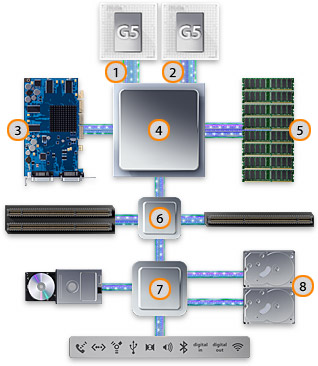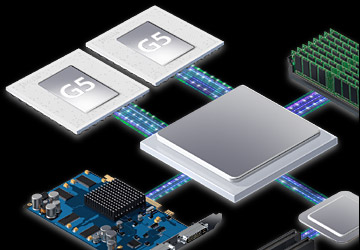
The Power Mac G5 boosts the performance of the PowerPC G5 processor
with a new high-bandwidth system architecture.
|
|
The Power Mac G5’s radically
re-designed, ultrahigh-bandwidth system architecture helps the Power PC G5
processor perform up to its full potential.
As PC users know only too well, bottlenecks in the system architecture
are usually what hold back the fastest processors. That’s why the Power Mac
G5’s new system architecture has been engineered to eliminate traffic jams
in your data path. The Power Mac G5’s new system architecture delivers phenomenal
throughput for the most intensive image-editing, rendering and scientific
computing tasks — without the stop-and-go traffic patterns that can choke
even the fastest processors.
Consider the 1GHz frontside bus, for instance: There’s one on
each processor for maximum throughput to and from the PowerPC G5 processor.
And the point-to-point system controller allows data to move directly between
all subsystems — without affecting the processor. Add to that the 400MHz,
dual-channel 128-bit memory bus, AGP 8X Pro graphics bus — as well as the
HyperTransport interface that connects the PCI-X controller and the I/O subsystems
to the system controller — and you’re looking at some impressive architectural
advances that speed up the data flow inside your computer.

|
 Frontside bus up to 1GHz
Frontside bus up to 1GHz
Designed to harness the power of the PowerPC G5 processor, a 1GHz,
64-bit bidirectional Double Data Rate (DDR) frontside bus maximizes throughput
between the processor and the system controller. And unlike most processor
interfaces, which can carry data in only one direction at a time and waste
precious time changing directions, the PowerPC G5 features two high-speed
unidirectional 32-bit data paths — one flowing continuously into the processor
and one flowing from the processor. This lets your data move in opposite
directions simultaneously, with no other demands on the data stream and no
wait time while the processor and system controller compete for use of the
bus. What’s more, the data streams integrate clock signals along with the
data, allowing the frontside bus to work at speeds of up to 1GHz for an astonishing
8GB per second of aggregate bandwidth.
 Dual independent 1GHz frontside buses
Dual independent 1GHz frontside buses
Naturally, dual processor systems get an even bigger performance boost.
Each PowerPC G5 processor has its own dedicated 1GHz bidirectional interface
to the system controller for a mind-boggling 16GB per second of total bandwidth
— more than twice the 6.4-GBps maximum bandwidth of Pentium 4-based systems
using the latest PC architecture. In addition to providing fast access to
main memory, this high-performance frontside bus architecture enables each
PowerPC G5 processor to discover and access data in the other processor’s
L1 and L2 caches for ultrafast performance.
 AGP 8X Pro graphics bus
AGP 8X Pro graphics bus
The new Power Mac G5 sports the latest graphics interface, AGP 8X
Pro, for next-generation 3D graphics. And “Pro” means you get up to 70 watts
of power for industrial-strength graphics. The new specification doubles
maximum transfer rates, and doubles the amount of data transferred in a single
AGP bus cycle. The 66MHz AGP 8X Pro bus strobes eight times per clock cycle,
resulting in a 533MHz data rate and blistering bandwidth of 2.1GB per second.
 Advanced PowerPC G5 System Controller
Advanced PowerPC G5 System Controller
Central to the overall performance of the PowerPC G5 is a new system
controller. This revolutionary Application Specific Integrated Circuit (ASIC)
is the industry’s fastest (in fact, it’s built using the same state-of-the-art
130-nanometer process technology as the PowerPC G5 processor itself). As
an advanced engineering concept, it’s beautiful in its simplicity: A point-to-point
architecture provides each primary subsystem with dedicated throughput to
main memory, neatly avoiding time-consuming contention for bandwidth (unlike
subsystems that share a bus and are compelled to constantly negotiate for
access and bandwidth across a common data path).
|

|
 400MHz dual-channel memory
400MHz dual-channel memory
The new Power Mac G5’s memory controller supports fast 400MHz, 128-bit
DDR SDRAM, and a dual-channel interface enables main memory to address two
banks of SDRAM at a time, reading and writing on both the rising and falling
edge of each clock cycle. This effectively doubles the bandwidth, enabling
the Power Mac G5 to reach a maximum memory throughput of up to 6.4GB per
second — an advance that’s especially welcome when you’re working with enormous
files. In addition, direct memory access (DMA) works with the point-to-point
system controller to give each subsystem — such as PCI cards and graphics
processing units — its own 6.4-GBps interface to main memory, without siphoning
power from your processors.
Thanks to the 64-bit PowerPC G5 processor, the Power Mac G5 can
address more memory than most other desktop PCs. The dual processor system
has eight DIMM slots, and can hold up to 8GB of memory — enough to process
huge data sets and rich media files right out of system RAM, without the
delay of having to access the disk drive.
 133MHz PCI-X expansion
133MHz PCI-X expansion
The Power Mac G5 features PCI-X, the hottest new advance in PCI technology.
The PCI-X protocol increases the PCI bus speed from 33MHz to 133MHz, and
the throughput from 266MBps to a combined total of 2GBps. PCI-X also operates
more efficiently, giving you more usable bandwidth at any clock frequency
— ideal for HD video and other high-bandwidth applications.
 High-performance I/O
High-performance I/O
The HyperTransport protocol integrates the Power Mac G5’s I/O subsystems
and connects them to the system controller. Serial ATA, Gigabit Ethernet,
FireWire, USB 2.0 and optical digital and analog audio are all integrated
through two bidirectional 16-bit, 800MHz HyperTransport interconnects for
a maximum throughput of 3.2GB per second.
 Serial ATA storage The Power Mac G5 can hold two internal
Serial ATA drives that support 1.5-Gbps throughput per channel (equivalent
to a 150 MBps data rate). Designed to meet the demands of digital video editing,
3D modeling and other data-intensive applications, Serial ATA is the next-generation
industry-standard storage interface that replaces the typical (a.k.a. Parallel)
ATA interface. Since each Serial ATA drive is on an independent bus, there’s
no competition for bandwidth as with Parallel ATA.
Serial ATA storage The Power Mac G5 can hold two internal
Serial ATA drives that support 1.5-Gbps throughput per channel (equivalent
to a 150 MBps data rate). Designed to meet the demands of digital video editing,
3D modeling and other data-intensive applications, Serial ATA is the next-generation
industry-standard storage interface that replaces the typical (a.k.a. Parallel)
ATA interface. Since each Serial ATA drive is on an independent bus, there’s
no competition for bandwidth as with Parallel ATA.
|
|



